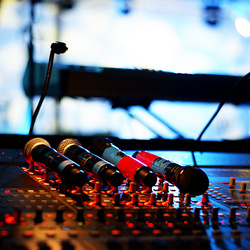
A limited quantity of wireless channels can be used in the 900 MHz and 2.4 GHz bands. Five compatible systems appear to be the current limit at 900 MHz, and 12 at the higher band.
For productions that involve many channels of wireless for performers and production communication, a combination of these new digital units and narrower band digital/digital hybrid units in the UHF spectrum will be necessary.
A wireless technology developed by Audio-Technica uses a proprietary method of ultra-wideband (UWB) pulses to carry the digitized and encoded voice signals from the transmitters to the receivers. Each 1 ms time period or “frame” is divided into 15 sub-frames, one as a header and the other 14 for wireless channels.
The pulse from a given transmitter lasts for about 2 nanoseconds (2 billionths of a second) and covers a 500 MHz bandwidth within the 6.35 GHz band, and its complementary receiver decodes it.

Overall RF power is low, and the range is relatively short at 75 feet, but it provides a very low latency, highly secure multi-channel solution for courtrooms and other sensitive locations. Audio bandwidth is 100 Hz to 12 kHz.
Audio Quality
Digital transmission, when properly encoded at the transmitter and decoded at the receiver, will produce an exact replica of the initial audio signal to the limits of the sampling frequency and the linearity of the transducer.
Full-bandwidth audio matching what is exiting the transducer is the result, even in the lowest and highest audio ranges and minus the potential artifacts from companding, RF transmission noise, and mismatches between the transmitter and receiver audio circuitry.
The digital units don’t use PLL circuitry so will reproduce a signal down to 20 or 25 Hz – below that of a 5-string bass. Despite the A/D and D/A conversion, the processors are fast enough that latency is undetectable at 1 to 4 ms.
I’ve had the opportunity to test the Shure PGX-D and Line 6 XD-V70 systems that use digital transmission in the 900 MHz and 2.4 GHz band respectively, and am impressed by the resulting audio quality with voice and instruments.

The frequency response, lack of noise tails, sustain of decaying notes, and overall lack of extraneous noise seem comparable to the highest end FM units, and at a moderate price point. They appear to be an excellent choice for applications requiring a few channels of wireless plus rapid and easy setup.
Digital Signal Processing
Some systems that are not transmitting digitally still use digital signal processing techniques before sending the signal. These methods are designed to efficiently maintain the audio quality prior to transmission, and faithfully reproduce it in the receiver.
With the scarcity of clear spectrum, efficient use while maintaining excellent audio quality is paramount for situations requiring multiple channels of wireless in harsh environments.
With digital signal processing, a narrower bandwidth signal is able to provide a level of audio quality unattainable using traditional analog companding and transmission methods.

Patented Digital Hybrid Wireless technology developed by Lectrosonics even takes 24-bit digital samples from the transducer and, using predictive algorithms, processes them before transmission into scrambled audio that rides the carrier as an analog signal. Using a reverse error-correction system at the receiver, the result is a full-bandwidth reproduction of the original audio.
One of the newer digital wireless system designs, the aforementioned XD-V70 from Line 6, uses mic modeling within its handheld transmitter, emulating several industry-standard microphones.
This emulation includes on-axis frequency response as well as output level. The system is designed so that if you unplugged the wired mic and substituted the wireless, the relative level and sound should be identical.
Another feature found in several wireless transmitters is softwareadjustable RF output power. With lower power, there is less potential for intermodulation interference, and more channels can be used – and interference between different closely located productions can be minimized by shortening the transmission range.
